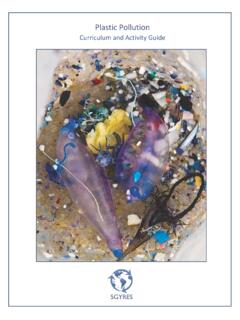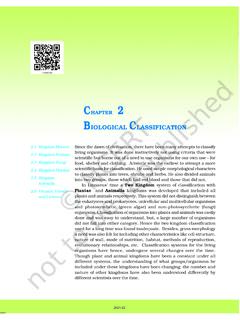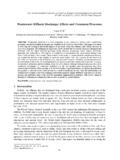Transcription of Identification of Freshwater Invertebrates
1 Identification of Freshwater Invertebrates 2008 Pennsylvania Sea Grant To request copies, please contact: Sara Gris email: Table of Contents A. Benthic 24 B. Phytoplankton Zooplankton Taxonomy is the science of classifying and naming organisms according to their characteris-tics. All living organisms are classified into seven levels: Kingdom, Phylum, Class, Order, Family, Genus, and Species.
2 This book classifies Benthic Macroinvertebrates by using their Class, Family, Genus, and Species. The Classes are the categories at the top of the page in colored text corresponding to the color of the page. The Family is listed below the common name, and the Genus and Spe-cies names are customarily written in italics, with the Genus being capitalized and the species being lower case. For example: Genus species. This book classifies Plankton by Phylum, Genus and Species. For each organism the following information is given: HA BITAT: Where the organism would be found. SIZE: The average size of the organism. Identification : Key features of the organism to help you identify it. INTERESTING FACT: An interesting fact about the organism, or how it affects aquatic life. 1 Identification : Resembling fat little spiders, they have a flat, round body with four hairy pairs of legs, and move swiftly through the water .
3 Size: 1 to 5 mm Habitat: Found in all Freshwater habitats. Like to swim in slow-flowing, shallow water among plants. Interesting Facts: While all water mites have the same simple body plan, some can have hard bod-ies, and others can have soft bodies. 2 water Mite Family: HYDRACHNIDAE Pollution Sensitive 3 Quagga Mussel (Dreissena bugensis) Family: DREISSENIDAE Pollution Tolerant Identification : Pale shells with finer stripes and more oval shape than zebra mussel shells. Size: Up to 51 mm Habitat: Able to live where any hard substrates (ex: rocks, pipes) exist on which they can attach. Interesting Facts: Quagga mussels are cousins of the zebra mussel! One important difference be-tween them is that quagga mussels can tolerate colder, deeper waters. Zebra Mussel (Dreissena polymorpha) Family: DREISSENIDAE Pollution Tolerant Identification : Yellow or brown D shaped shell, usually with dark and light colored stripes; usually grow in clusters.
4 Size: Up to 51 mm but most are less than 25 mm Habitat: Generally found in algae -rich water from 2 to 10 meters deep. Interesting Facts: Zebra mussels live in colonies of 30,000 to 50,000 square meters and each mus-sel is capable of filtering 1 liter of water per day! 4 Fatmucket Clam (Lampsilis siliquoidea) Family: UNIONIDAE Pollution Sensitive Identification : Elongated-elliptical shell. Size: About 90 mm Habitat: Lakes and small- to medium-sized streams in mud, sand, or gravel. Interesting Facts: The male fatmucket clam is usually larger than the female. Giant Floater Clam (Pyganodon grandis) Family: UNIONIDAE Pollution Sensitive Identification : Elliptical, smooth shell; shell is light yellow or yellowish-green in younger individuals and dark green to brown in older shells.
5 Size: About 127 mm Habitat: Ponds, lakes, and sluggish mud bot-tomed pools of creeks and rivers. Interesting Facts: Giant floater clams can reach up to 254 millimeters in length! Identification : Thin cylindrical segmented bodies; may be red, tan, brown, black; may also have small hairs that are not easily seen. Size: 1 to 30 mm Habitat: Soft sediments in bodies of Freshwater that are rich in organic matter. Interesting Facts: Aquatic worms are capable of inhabiting areas of low dissolved oxygen concentra-tions and areas that contain large amounts of organic pollution. 5 Aquatic Worms (Limnodrilus sp.) Family: TUBIFICIDAE Identification : Flat body; brown with spots, segmented (usually 34 segments). Size: 10-250 mm Habitat: Shallow waters. Interesting Facts: Leeches were commonly used in the past for medical procedures on humans.
6 Leech (Helobdella sp.) Family: GLOSSIPHONIIDAE Pollution Tolerant Pollution Tolerant Identification : Soft body inside a hard, spiral-shaped shell. The spiral opening to the shell is usually on the right. Size: 2 to 70 mm Habitat: Usually found grazing on a variety of substrates. Interesting Facts: Gilled snails have a shell door called an oper-culum, which they can close when they go into their shell. Identification : Small and cone-shaped with a flat bottom. Size: 4 to 5 mm Habitat: Likes to inhabit rocky riffles, and low nutrient, well-oxygenated streams with good water quality. Interesting Facts: Freshwater limpets are pulmonates, meaning they breathe through a lung, but they also have gills to aid in respiration. 6 Freshwater Limpet Family: ANCYLIDAE Pollution Sensitive Pollution Sensitive Gilled Snail Family: LYMNAEIDAE Identification : Hard, coiled shell.
7 Usually gray or black. Size: 2 to 70 mm Habitat: Clean, quiet waters. Interesting Facts: Snails have a muscular foot with slime glands. The slime aids them while they crawl on their foot. 7 Identification : Soft body inside a hard, spiral shaped shell. The spiral opening to the shell is usually on the left. Size: 2 to 70 mm Habitat: Ponds and pools where oxygen is low, and slow polluted rivers. Interesting Facts: The snail s shell provides protection from enemies and acts as a handy oxygen con-tainer. When a snail is seen crawling up-side down on the surface of a pond, it is gathering fresh air into its shell. Orb Snail Family: PLANORBIDAE Lunged (Pouch) Snail Family: PHYSIDAE Pollution Tolerant Pollution Tolerant 8 Identification : Brown and radially symmetrical. It consists of a stalk that supports a crown of five to eight long tentacles.
8 The tentacles, which contain sting-ing cells, surround a mouth that is capable of swallowing large microcrus-taceans like copepods and waterfleas. Size: Up to 3 mm Habitat: Submerged vegetation in unpolluted ponds, ditches, and streams in quiet shallows. Interesting Facts: Hydras reproduce asexually by budding. Changes in the environment (temperature, carbon dioxide, light, or an increase in noxious substances) induce sexuality. Hydra (Hydra oligactis) Family: HYDRIDAE Pollution Sensitive 9 Pollution Tolerant Pollution Intermediate Predacious Diving Beetle Family: DYTISCIDAE Identification : Smooth, oval, and streamlined with hairy, paddle-shaped hind legs. Size: Up to 13 mm Habitat: Primarily found in the still waters of lakes and ponds, but can also be encountered in streams.
9 Interesting Facts: Diving beetles breathe through an air bubble under their wing that they take in when they break the surface. Aquatic Beetle Larva Family: ELMIDAE Identification : Distinct head with well-developed chewing mouth parts. The body is long with many segments and is relatively hard and stiff. Size: 1 to 6 mm Habitat: Specially adapted to cling to rocks in fast flowing water . Interesting Facts: Aquatic beetle larvae are often called water tigers because they are fierce hunters. 10 Riffle Beetle Family: ELMIDAE Pollution Sensitive Identification : Small, oval body, usually black with one pair of tiny antennae. Size: 1 to 6 mm Habitat: Found in clean, fast-moving waters and usually indicate an ample oxygen sup-ply. Interesting Facts: Riffle beetles are able to fly when they emerge from the water as juveniles, but lose this ability when they return to the water .
10 Whirligig Beetle Family: GYRINIDAE Identification : Black, or nearly black, flattened and streamlined for aquatic life. Size: 3 to 35 mm Habitat: Often congregate in both slow-, and fast-moving waters, especially in streams and ponds. Spend most of their lives at the surface of the water . Interesting Facts: Whirligig beetles eyes are divided, allowing them to see both above and below the water surface at the same time. Pollution Intermediate 11 Pollution Intermediate water Scavenger Beetle Family: HYDROPHILIDAE Identification : Smooth, oval, dark brown or black bod-ies and short, hairy, clubbed antennae. Some have a conspicuous ridge on the underside of the thorax. Size: Approximately 40 mm Habitat: Usually found in ponds, shallow lakes, and along the shoreline of flowing water .



